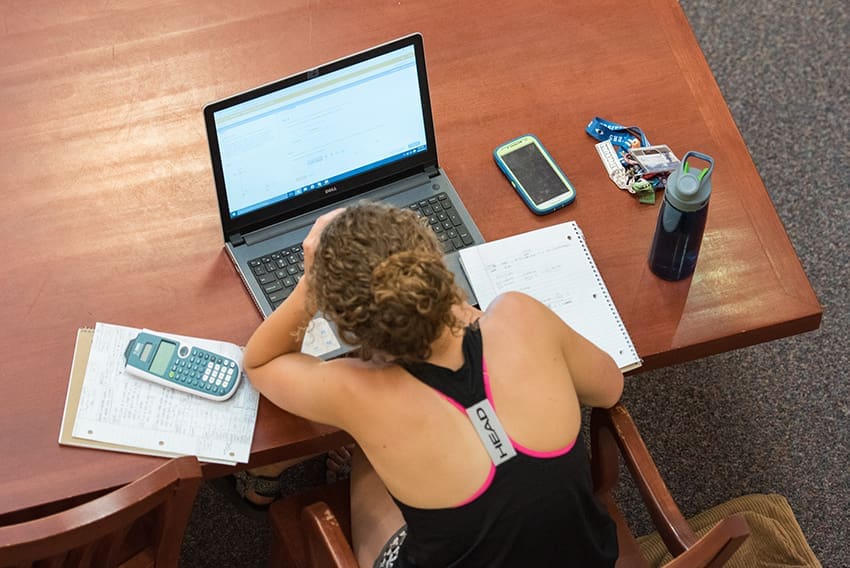AcademicsSophomore Slump — Fact or Fiction?
Diane Schwemm

The sophomore slump is either "ubiquitous" and "unavoidable" or a total non-issue depending on who you talk to.
If your second-year student isn't experiencing it, you can feel grateful. However, if you sense a slump, you're not alone.
Here's what may be going on and how you can help your sophomore turn things around (or fend off the syndrome altogether if you are the parent of a first-year student).
The novelty — and relative ease — of the first year is over.
Students and parents alike agree that sophomore year means the "excitement and new experiences" of the first year are a thing of the past, "but you haven't found your rhythm as you do in junior year" (Ziv, Pomona College).
Catherine, a Baylor University student, agreed. She also pointed out that even as enthusiasm and motivation falter a bit, academic pressure increases for second-year students. "Many prerequisites are out of the way, and sophomores begin taking upper-level classes and classes specific to their majors. Accountability is higher," she said, and there's none of the "wiggle room" professors sometimes allow first-year students. The "slump," in other words, can equate to a GPA dip as well as a generalized slump in spirits.
Being prepared for change will help students deal with the transition and enjoy the many good things that come with sophomore year, like closer friendships, leadership opportunities, faculty connections, and more relevant classes.
Some second-year students are still searching for a place on campus — a club, team, or campus job that might create a feeling of home. Students who don't know what they want to major in may feel anxious and unfocused. "My son is slow to understand his big picture and how he can best use his talents," one parent observed.
Schools recognize that sophomore slump is a problem.
Many universities have instituted Second/Sophomore Year Experience (SYE) programs to counter the lack of momentum and connection that can lead to a sophomore slump. At large universities, SYE living-learning communities are designed to keep students living on campus and engaged. Ohio State, for example, has documented higher retention and graduation rates among students who live on campus sophomore year instead of moving off campus (for retention, 95.7% vs. 88.6%, and for graduation, 88.2% vs. 76.5 %).
SYE programming includes events that connect students with faculty members. At Duke, students attend "career luncheons" in the faculty dining hall; Colorado State University hosts a "True Faculty Story Dinner Series" just for sophomores; Williams College calls their monthly meet-ups that introduce sophomores to a variety of featured guests "M&Ms" ("learn, meet, mingle and munch").
Special opportunities may include unique study abroad programs just for sophomores, peer mentoring, special outdoor experiences, Academic Transition Workshops, monthly newsletters, social programs, leadership opportunities, and parties to celebrate being halfway to graduation.
This is what students who escape sophomore slump do and do well.
They get involved.
- "Sophomore year, I led a service group that brought food to low-income and homeless people near my university," a recent graduate recalled. "It kept me busy and provided a refreshing contrast to academics."
- "My daughter started to go to church which was something she did growing up but did not do freshman year," one parent said. "It helped her feel more connected."
- "My son sings in two choral groups. He's saving money for a Glee Club spring break trip to South America." (Parent of a current sophomore)
They focus on their major and career.
- "My daughter started to get more into the classes for her major and loved her major, so that really helped," the parent of a recent graduate said.
- "I'm working as a Physics T.A. — it's more connected to what I'm learning than my previous campus job." (A current sophomore)
- "My daughter is busily researching study abroad and domestic exchange programs." (Mother of current sophomore)
- "My son wanted a 'serious' summer job between sophomore and junior year, so he was hyper-focused on resumé-writing and –building," recalled the parent of a recent graduate.
- "Sophomore year, my daughter spent most of the second semester researching and applying for internships in New York. Her persistence paid off — she found meaningful summer work in a community education program and got internship credit."
- "I did an internal transfer, and now I'm in the program where I can take the classes I really want. College finally makes sense to me!" (Current sophomore)
They enjoy deeper friendships, better housing, and expanded social opportunities.
- "The sophomore housing situation gave both my kids another level of independence and fun with self-selected roommates," Lucy remembered, "but they weren't saddled yet with the stress of being renters."
- "I'm getting off campus more — to see a concert in L.A., or going up to San Francisco to stay with a friend over fall break." (Current sophomore)
- "Last year, my son was in a one-room double with a guy he barely spoke to. This year he's living with a great group of friends. They all have singles, but they hang out in the common room and do things together. I can tell he's happy." (Parent of current sophomore)
They take care of health and wellness.
- "I took multiple dance classes for class credit and for recreation," a recent grad said. "This kept me in shape and was a great stress relief."
- "Health problems were casting a cloud earlier this semester. But I recently figured out that I have a ton of allergies, and if I take care of that going forward, it should help my outlook." (Current sophomore)
- "Sophomore year was when I discovered I could rent hiking and ski gear very cheaply from the Outdoor Club," an upperclassman recalled. "I got outside more, and that actually helped my grades."
Parents can support slumping sophomores by listening to and encouraging them. Students who feel unfocused and indecisive may benefit from time in the career center or an appointment with an academic advisor. Involvement on campus and good health are both spirit boosters. When students are grounded in the positive, they can be more resilient if or when they do hit a bump in the road.
Join Our College Parent Newsletter!
Get stories and expert advice on all things related to college and parenting.
Diane Schwemm is a freelance writer and editor. While Senior Editor and Content Manager at CollegiateParent, she helped create dozens of resources and publications for college students and families including many issues of the CollegiateParent Magazine and Insider. Diane lives in Boulder, Colorado and is a member of her local newspaper’s Community Editorial Board.

